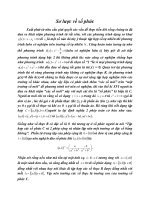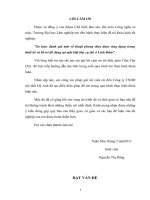SƠ LƯỢC VỀ THAY ĐỔI DÒNG TIỀN THEO PHƯƠNG PHÁP GIÁN TIẾP TRONG CHU KỲ HOẠT ĐỘNG - Full 10 điểm
Bạn đang xem bản rút gọn của tài liệu. Xem và tải ngay bản đầy đủ của tài liệu tại đây (1.4 MB, 59 trang )
JAVASERVER PAGES
Instructor:
43e-BM/HR/HDCV/FSOFT V1.2 - ©FPT SOFTWARE - Fresher Academy - Internal Use 1
Learning Goals
Know about
Java Server
Pages (JSP)
Can use JSP
to build Web
application
43e-BM/HR/HDCV/FSOFT V1.2 - ©FPT SOFTWARE - Fresher Academy - Internal Use 2
Table of contents
◊ JSP Introduction
◊ JSP Scripting Element
◊ JSP Implicit Objects
◊ Expression language
◊ Q&A
43e-BM/HR/HDCV/FSOFT V1.2 - ©FPT SOFTWARE - Fresher Academy - Internal Use 3
Section 1
JSP INTRODUCTION
43e-BM/HR/HDCV/FSOFT V1.2 - ©FPT SOFTWARE - Fresher Academy - Internal Use 4
JSP Introduction (1/2)
❖ What is JSP?
JavaServer Pages (JSP) is a technology for developing web pages that
support dynamic content which helps developers insert java code in
HTML.
As an extension of Servlet technology
JSPs are essential an HTML page with special JSP tags embedded.
All JSP programs are stored as a .jsp files
HTML page JSP page
43e-BM/HR/HDCV/FSOFT V1.2 - ©FPT SOFTWARE - Fresher Academy - Internal Use 5
JSP Introduction (2/2)
❖ Servlet:
Java Servlets are programs that run on a Web server and act as a
middle layer between a request coming from a Web browser and
databases on the HTTP server.
❖ JSP vs Servlet:
43e-BM/HR/HDCV/FSOFT V1.2 - ©FPT SOFTWARE - Fresher Academy - Internal Use 6
Architecture of a JSP Application
❖ JSP plays a key role and it is responsible for of processing
the request made by client.
Client (Web browser) makes a request
JSP then creates a bean object which then fulfills the request and
pass the response to JSP
JSP then sends the response back to client
43e-BM/HR/HDCV/FSOFT V1.2 - ©FPT SOFTWARE - Fresher Academy - Internal Use 7
JSP Process
Steps required for a JSP request:
1. The user goes to web side made using JSP. The web browser makes the request via
the Internet.
2. The JSP request gets sent to the Web server.
3. The Web server recognizes that the file required is special (.jsp), therefore passes the JSP file to the
JSP servlet engine.
4. If the JSP file has been called the first time, the JSP file is parsed, otherwise goto step 7.
5. The next step is to generate a special Servlet from the JSP file. All the HTML required is converted
to println statements.
6. The Servlet source code is compiled into a class.
7. The servlet is instantiated, calling the init and service methods.
8. HTML from the Servlet output is sent via the Internet.
9. HTML results are displayed on the user's web browser.
43e-BM/HR/HDCV/FSOFT V1.2 - ©FPT SOFTWARE - Fresher Academy - Internal Use 8
Example
First Example
43e-BM/HR/HDCV/FSOFT V1.2 - ©FPT SOFTWARE - Fresher Academy - Internal Use 9
Practical time
1. Create Dynamic Web Project:
2. Create jsp page in WebContent
folder
43e-BM/HR/HDCV/FSOFT V1.2 - ©FPT SOFTWARE - Fresher Academy - Internal Use 10
Practical time
Create a simple jsp
page:
43e-BM/HR/HDCV/FSOFT V1.2 - ©FPT SOFTWARE - Fresher Academy - Internal Use 11
Practical time
3. Setup tomcat server:
❖ Download and unzip Apache Tomcat .
❖ Open Window | Preferences | Server | Installed Runtimes to create a
Tomcat installed runtime.
❖ Click on Add... to open the New Server Runtime dialog, then select your
runtime under Apache
4. Run your code
43e-BM/HR/HDCV/FSOFT V1.2 - ©FPT SOFTWARE - Fresher Academy - Internal Use 12
Section 2
JSP SCRIPTING ELEMENT
43e-BM/HR/HDCV/FSOFT V1.2 - ©FPT SOFTWARE - Fresher Academy - Internal Use 13
Scriptlet
❖ Scriptlet (<% ... %>) - also called “Scripting Elements”
Enable programmers to insert Java code in JSPs
Performs request processing
For example, to print a variable:
Code snippet
<%
String username = "alliant";
out.println(username);
%>
43e-BM/HR/HDCV/FSOFT V1.2 - ©FPT SOFTWARE - Fresher Academy - Internal Use 14
JSP Tags
❖ Declaration tag (<%! %>)
Allow the developer to declare variables or methods.
Code snippet
<%!
private int counter = 0;
private String getAccount(int accountNo);
%>
❖ Expression tag (<%= %>)
Allow the developer to embed any Java expression and is short for
out.println()
Code snippet
<%!
<%=new java.util.Date()%>
%>
43e-BM/HR/HDCV/FSOFT V1.2 - ©FPT SOFTWARE - Fresher Academy - Internal Use 15
Directive tags (1/3)
❖ Directive[chỉ thị] (<%@ directive... %>
Give special information about the page to the JSP
container.
Enable programmers to specify:
▪ Page settings (page directive):
Ex:<%@page import="java.sql.Statement"%>
▪ Content to include from other resources (Include directive).
Ex:<%@include file="Connection.jsp"%>
▪ Tag libraries to be used in the page (Tag library).
Ex:<%@ taglib prefix="c" uri=" />
43e-BM/HR/HDCV/FSOFT V1.2 - ©FPT SOFTWARE - Fresher Academy - Internal Use 16
Directive tags (2/3)
❖ Content to include from other resources (Include
directive).
Code snippet
<%@page import="java.util.Date"%>
<%@ page language="java" contentType="text/html; charset=ISO-8859-1"
pageEncoding="ISO-8859-1"%>
" /><html>
<head>
<meta http-equiv="Content-Type" content="text/html; charset=ISO-8859-1">
<title>Directive tag</title>
</head>
<body>
<%@include file="Header.jsp"%>
<hr />
This is main content
<%=new Date()%>
<hr />
<%@include file="Footer.jsp"%>
</body>
</html>
43e-BM/HR/HDCV/FSOFT V1.2 - ©FPT SOFTWARE - Fresher Academy - Internal Use 17
Directive tags (3/3)
❖ Tag libraries to be used in the page (Tag library).
✓ Add jstl lib
✓ Defining core tags:
<%@ taglib prefix="c" uri=" />
Code snippet
TRAINEE FULL INFORMATION
<table>
<tr>
<th>Id</th>
<th>Trainee Name</th>
<th>Salary</th>
</tr>
<!-- traineeData: a list of trainee -->
<c:forEach items="${traineeData}" var="trainee">
<tr>
<td>${trainee.getId()}</td>
<td>${trainee.getName()}</td>
<td>${trainee.getSalary()}</td>
</tr>
</c:forEach>
</table>
43e-BM/HR/HDCV/FSOFT V1.2 - ©FPT SOFTWARE - Fresher Academy - Internal Use 18
Action tags (1/2)
❖ Action (<%action... %>
JSP Actions lets you perform some action.
Provide access to common tasks performed in a JSP:
• Including content from other resources.
• Forwarding the user to another page.
• Interacting with JavaBeans.
Delimited by <jsp:action> and </jsp:action>.
43e-BM/HR/HDCV/FSOFT V1.2 - ©FPT SOFTWARE - Fresher Academy - Internal Use 19
Action tags (2/2)
Action Description
<jsp:include>
<jsp:forward> Dynamically includes another resource in a JSP. As the JSP executes,
<jsp:plugin> the referenced resource is included and processed.
<jsp:param> Forwards request processing to another JSP, servlet or static page. This
JavaBean Manipulation action terminates the current JSP’s execution.
<jsp:useBean> Allows a plug-in component to be added to a page in the form of a
browser-specific object or embed HTML element. In the case of a
<jsp:setProperty> Java applet, this action enables the downloading and installation of the
Java Plug-in, if it is not already installed on the client computer.
<jsp:getProperty> Used with the include, forward and plugin actions to specify
additional name/value pairs of information for use by these actions.
Specifies that the JSP uses a JavaBean instance. This action specifies
the scope of the bean and assigns it an ID that scripting components can
use to manipulate the bean.
Sets a property in the specified JavaBean instance. A special feature of
this action is automatic matching of request parameters to bean
properties of the same name.
Gets a property in the specified JavaBean instance and converts the
result to a string for output in the response.
43e-BM/HR/HDCV/FSOFT V1.2 - ©FPT SOFTWARE - Fresher Academy - Internal Use 20








